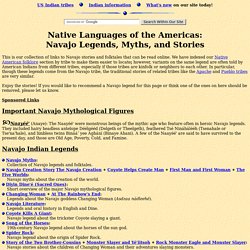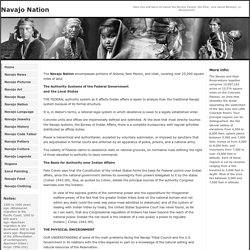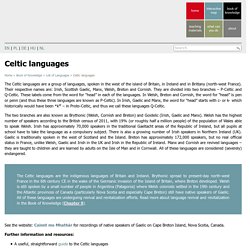

Navajo Legends (Folklore, Myths, and Traditional Indian Stories) Indian Languages Indian Cultures What's new on our site today!

This is our collection of links to Navajo stories and folktales that can be read online. We have indexed our Native American folklore section by tribe to make them easier to locate; however, variants on the same legend are often told by American Indians from different tribes, especially if those tribes are kinfolk or neighbors to each other. Navajo Nation. More info: The Navajo and Hopi Reservations together comprise 15,087,163 acres or 23,574 square miles on the Colorado Plateau, an area that straddles the divide separating the watershed of the San Juan and Little Colorado Rivers.

Four principal regions can be distinguished: the flat alluvial valleys at elevations from 4,500 to 6,000 feet; upland plains between 5,500 and 7,000 feet; mesas at from 6,000 to 8,000 feet; and mountains from 7,500 to over 10,000 feet in altitude. Each of these regions is cut by canyons ranging from a few hundred to 2,000 feet in depth. Fact Sheet. Important Note The Navajo Nation recognizes Daylight Savings Time, even when the state of Arizona does not.

Please be aware of this while on your tour. For example, when it is 2 PM in Arizona, it is 3 PM on the Navajo Nation during the spring and summer months from March to November. Introduction: Legend of the Banshee. What is a Banshee?

A Banshee is said to be a fairy in Irish legend and her scream is believed to be an omen of death. The scream is also called ‘caoine’ which means ‘keening’ and is a warning that there will be an imminent death in the family and as the Irish families blended over time, it is said that each family has its own Banshee! A Banshee is a disembodied spirit and can appear in any of the following forms: A beautiful woman wearing a shroudA pale woman in a white dress with long red hairA woman with a long silver dress and silver hairA headless woman carrying a bowl of blood that is naked from the waist upAn old woman with frightening red eyes, a green dress and long white hairAn old woman with a veil covering her face, dressed all in black with long grey hair Banshees are often dipicted as women spirits with long hair who scream through the night.
Origins Banshees – The Good & Bad. Celtic Mythology – Mythopedia. Celtic Government and Society. By Annie Whitehead.

Religion of the Celts. The climate of the UK - Atmosphere and climate - Edexcel - GCSE Geography Revision - Edexcel - BBC Bitesize. Languages In Danger. The Celtic languages are a group of languages, spoken in the west of the island of Britain, in Ireland and in Brittany (north-west France).

Their respective names are: Irish, Scottish Gaelic, Manx, Welsh, Breton and Cornish. They are divided into two branches – P-Celtic and Q-Celtic. These labels come from the word for “head” in each of the languages. In Welsh, Breton and Cornish, the word for “head” is pen or penn (and thus these three languages are known as P-Celtic). In Irish, Gaelic and Manx, the word for “head” starts with c- or k- which historically would have been *kw – in Proto-Celtic, and thus we call these languages Q-Celtic. Japanese Mythology: 5 Legends and Ancient Myths and Legends.
Do you have a fascination with old Japanese myths and legends?

Japanese mythology is full of epic tales of adventure along with deep reflections on life. Learning about Japanese history and culture is also a great idea for those studying the language. A little bit of background before we dive into the myths: Japanese mythology consists of stories derived from old folk beliefs and incorporates elements of Shinto mythology as well as Buddhism. Passed down from generations through both spoken word and writing, there is a vast number of ancient tales that touch upon virtually every aspect of life.
Japanese Mythology – Mythopedia. Japanese mythology. Japanese mythology, body of stories compiled from oral traditions concerning the legends, gods, ceremonies, customs, practices, and historical accounts of the Japanese people. Most of the surviving Japanese myths are recorded in the Kojiki (compiled 712; “Records of Ancient Matters”) and the Nihon shoki (compiled in 720; “Chronicles of Japan”). These works tell of the origin of the ruling class and were apparently aimed at strengthening its authority. Therefore, they are not pure myths but have much political colouring. They are based on two main traditions: the Yamato Cycle, centred around the sun goddess Amaterasu Ōmikami, and the Izumo Cycle, in which the principal character is Susanoo (or Susanowo) no Mikoto, the brother of Amaterasu. Genealogies and mythological records were kept in Japan, at least from the 6th century ad and probably long before that.
Get exclusive access to content from our 1768 First Edition with your subscription.